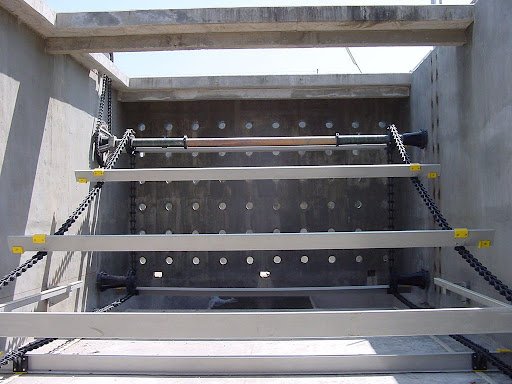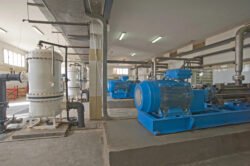Rectangular Primary Clarifier in Wastewater Treatment: Efficiency and Design Principles

In the realm of wastewater treatment, the rectangular primary clarifier is an essential first-stage component designed to reduce solids and organic loads by way of sedimentation. This process facilitates the removal of settleable solids and particulate matter from wastewater before it undergoes further treatment or purification steps. The design and operation of rectangular primary clarifiers allow for optimized flow distribution, which in turn improves the efficiency and reliability of the overall treatment process.
Rectangular primary clarifiers are characterized by their simple yet effective structure, typically involving a large basin through which wastewater is allowed to flow slowly. This quiescent state encourages solids to settle out due to gravity, separating them from the liquid component. The settled material, commonly referred to as sludge, collects at the bottom and is mechanically removed, while the clarified water flows out of the clarifier for additional treatment. Continuous advancements and innovations in clarifier design aim to enhance performance, minimize maintenance requirements, and address environmental regulations.
Key Takeaways
- Rectangular primary clarifiers are crucial for sedimentation in wastewater treatment.
- Their design ensures efficient solid separation, aiding in treatment reliability.
- Innovations in clarifier technology focus on efficiency and regulatory compliance.
Fundamentals of Primary Clarification
In the wastewater treatment process, primary clarification is the essential first step where solids are separated from the liquid. This phase serves to prepare the wastewater for subsequent treatment stages.
Purpose of Primary Clarification
The primary goal of primary clarification is to remove settleable organic and inorganic solids by sedimentation, and also to remove materials that float by skimming. In the context of a Rectangular Primary Clarifier, the process involves the wastewater flowing through a large, open tank, which provides sufficient retention time for the solids to settle to the bottom, forming sludge, while lighter materials like oils and grease rise to the surface.
Design Principles of Rectangular Clarifiers
The design of Rectangular Primary Clarifiers focuses on optimizing flow distribution and maximizing solid removal. These clarifiers are built with length-to-width ratios typically greater than 4:1, ensuring a uniform velocity distribution that prevents short-circuiting and allows particles adequate time to settle. Baffles at the inlet distribute the flow evenly across the entire cross-section of the clarifier, reducing turbulence and enhancing settling. Sludge collection mechanisms are usually designed at the bottom of the tank, continuously moving settled solids toward a hopper for further processing.
Components and Functionality
The rectangular primary clarifier is a key component in wastewater treatment that operates to remove suspended solids through sedimentation. It consists of several essential subsections that each play a vital role in the effective separation of solids from wastewater.
Inlet and Outlet Zones
In the Inlet Zone, wastewater enters the clarifier. This zone is designed to distribute the flow evenly across the cross-section of the clarifier to minimize turbulence and promote effective settling. The Outlet Zone allows for the clarified water to exit the clarifier while preventing the re-entrainment of settled solids, often utilizing weirs or baffles to control the water level and flow.
Settling Zone
The Settling Zone is the largest part of a rectangular primary clarifier. Here, gravity acts upon the particles suspended in the wastewater, causing them to settle to the bottom. This zone is designed to provide sufficient residence time for effective sedimentation and is the primary locus where solids separate from the liquid.
Effective depth: Usually varies from 2.5 to 3.5 meters, depending on the design. Surface Loading Rate: Typically maintained between 30-80 m³/m².d.
Sludge Collection System
At the bottom of a rectangular primary clarifier is the Sludge Collection System. It typically consists of a series of scrapers that move the settled solids—or sludge—toward a hopper for removal from the clarifier. The collection mechanism operates at a slow, continuous pace to ensure that the sludge is conveyed without resuspending the solids.
Sludge Removal: Usually occurs at one end of the clarifier. Operation: Can be continuous or intermittent based on the design parameters and sludge characteristics.
Process Optimization
In the realm of wastewater treatment, optimizing a Rectangular Primary Clarifier is crucial for enhancing the overall treatment process. Proper optimization entails improvements in flow distribution and solids removal efficiency, ensuring that the clarifier operates at peak performance.
Flow Distribution
The uniform distribution of flow across the entire surface area of a Rectangular Primary Clarifier is essential for its efficient operation. Engineers may employ baffles or inlet structures to minimize turbulence and prevent short-circuiting, thus achieving an even spread of the influent. This helps in maximizing contact time and minimizes the risk of solids escape.
Solids Removal Efficiency
The effectiveness of a Rectangular Primary Clarifier in wastewater treatment is largely judged by its solids removal efficiency. To maximize this parameter, one should maintain a proper surface loading rate and detention time, which are critical factors in the settling process. Adjusting the rake mechanism speed and ensuring consistent sludge removal contribute significantly to maintaining a high removal efficiency. Maintaining a clear interface between the sludge and the supernatant fluid above can prevent the re-suspension of solids, which is vital for the clarifier’s optimal performance.
Maintenance and Operational Considerations
The maintenance of a rectangular primary clarifier is crucial for ensuring efficient wastewater treatment. Regular cleaning and timely troubleshooting of common issues are key operational considerations.
Cleaning and Upkeep
Rectangular primary clarifiers require consistent cleaning to prevent the build-up of sludge and scum which could hinder their performance. They should be inspected daily for any signs of overflow or unusual accumulation of solids. It is essential that the following are performed regularly:
- Surface Skimming: To remove floating solids and scum to maintain an effective surface area for separation.
- Sludge Removal: Sedimented sludge should be cleaned out at prescribed intervals to prevent septic conditions and maintain treatment efficiency.
Proper upkeep also involves inspecting weirs and baffles for debris that may obstruct the flow of water, and ensuring that all mechanical components such as scrapers are in good working condition.
Troubleshooting Common Issues
When operational issues arise with a rectangular primary clarifier, they must be addressed promptly to prevent a decline in the wastewater treatment process. Some common problems include:
- Inadequate Removal of Solids: If solids are not adequately being removed, check for the scraper mechanism’s proper function and adjust the removal rate of sludge.
- Odor Problems: Foul odors can indicate that sludge is being held for too long before removal. Increasing the frequency of sludge withdrawal may be necessary.
Rectangular primary clarifiers are key in separating solids from wastewater early in the treatment process; thus, maintaining them is crucial for the overall efficacy of wastewater treatment plants. Regular cleaning and prompt troubleshooting are essential for their successful operation.
Advancements and Innovations
With ongoing technological advancements, the design and functionality of rectangular primary clarifiers in wastewater treatment have seen significant innovation. These enhancements aim to improve efficiency, reduce costs, and contribute to more sustainable operations.
Technological Improvements
The latest technological improvements in rectangular primary clarifiers involve enhanced sludge removal and more precise flow distribution. Automated sludge collection systems have become more sophisticated, allowing for efficient sludge extraction without the need for manual intervention. Furthermore, the introduction of real-time monitoring equipment has enabled the precise measurement of sludge levels and clarity of effluent water. This enables timely adjustments, leading to better performance Improving clarifier models by describing extracellular polymeric substances.
- Real-Time Sensors: Implementing sensors for continuous monitoring of water quality and sludge volume.
- Automated Controls: Utilizing advanced control systems for automated adjustments and optimized performance.
Sustainability in Design
Sustainability has gained focus in the design of rectangular primary clarifiers, with efforts aimed at reducing the environmental impact. The materials used for construction are now often more sustainable and have lower embodied energy. The design principles also increasingly consider the overall lifecycle of the clarifier, from construction to operation and eventual decommissioning. There is a growing emphasis on reducing water usage and energy consumption through innovative design features such as energy-efficient motors and solar-powered units for low-power tasks.
- Materials: Usage of sustainable, long-lasting materials for construction.
- Energy Efficiency: Integration of energy-saving components and renewable energy solutions.
Regulatory and Environmental Impact
Rectangular primary clarifiers are essential in wastewater treatment to achieve compliance with regulatory standards and to minimize environmental impacts. They often set the stage for subsequent treatments by effectively removing solids and organic matter from wastewater.
Compliance with Regulations
In the United States, municipal wastewater treatment plants are regulated under the Clean Water Act, which requires specific levels of pollutant removal before discharge. Clarifiers, including rectangular primary clarifiers, must consistently meet the regulatory definition of secondary treatment, which stipulates that at least an 85 percent reduction in both Biochemical Oxygen Demand (BOD) and suspended solids is necessary. Noncompliance can lead to significant fines and legal actions. Design standards, like those outlined in Montana’s DESIGN STANDARDS FOR PUBLIC SEWAGE SYSTEMS, emphasize the importance of rectangular primary clarifiers in meeting these requirements.
Impact on Wastewater Treatment
The performance of rectangular primary clarifiers has a direct impact on the efficiency of the entire wastewater treatment process. They are responsible for the initial phase of pollutant removal, where approximately one-third of the BOD and one-half of the suspended solids are eliminated (Municipal Wastewater and Sludge Treatment – US EPA). By effectively reducing these contaminants early on, rectangular primary clarifiers not only prepare wastewater for secondary treatment but also protect the environment from excessive nutrient loading, which can lead to detrimental conditions such as eutrophication in receiving water bodies.
Frequently Asked Questions
What is the function of a primary clarifier in water treatment processes?
A primary clarifier in water treatment processes serves to remove settleable and floating solids from wastewater. This initial stage of treatment is critical for reducing pollutants before the wastewater undergoes secondary biological treatment.
How do rectangular and circular clarifiers compare in terms of performance and design?
Rectangular and circular clarifiers differ mainly in shape, which affects flow distribution and sludge collection. Circular clarifiers are typically better suited for locations where space is a constraint, while rectangular clarifiers often allow for easier maintenance and can be installed in series for continuous flow.
Can you explain the design considerations for a rectangular clarifier in a wastewater treatment facility?
The design of a rectangular clarifier must consider factors such as the flow rate, detention time, surface area, and depth to ensure efficient solids removal. They are designed with mechanical scrapers to move settled solids toward a hopper for removal.
What are the main factors affecting the efficiency of a rectangular primary clarifier?
The efficiency of a rectangular primary clarifier is influenced by factors such as surface loading rate, sludge removal efficiency, and proper distribution of influent. Additionally, the aspect ratio of length to width is also a critical design factor.
In what scenarios is a rectangular clarifier preferred over a circular one for wastewater treatment?
Rectangular clarifiers are often preferred in wastewater treatment when the facility requires a modular setup that can be expanded over time. They are also chosen when the layout of the plant precludes the use of circular clarifiers due to space restrictions or for integrating with existing rectangular treatment channels.


